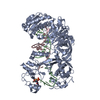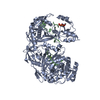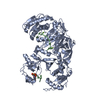+ Open data
Open data
- Basic information
Basic information
| Entry | Database: PDB / ID: 7yg6 | ||||||
|---|---|---|---|---|---|---|---|
| Title | Cryo-EM structure of the EfPiwi(N959K) in complex with piRNA | ||||||
 Components Components |
| ||||||
 Keywords Keywords | RNA BINDING PROTEIN/RNA / piRNA / Piwi protein / Argonaute / RNA binding protein / RNA BINDING PROTEIN-RNA complex | ||||||
| Function / homology |  Function and homology information Function and homology informationregulatory ncRNA-mediated gene silencing / cell differentiation / RNA binding / cytoplasm Similarity search - Function | ||||||
| Biological species |  Ephydatia fluviatilis (invertebrata) Ephydatia fluviatilis (invertebrata) Homo sapiens (human) Homo sapiens (human) | ||||||
| Method | ELECTRON MICROSCOPY / single particle reconstruction / cryo EM / Resolution: 3.2 Å | ||||||
 Authors Authors | Li, Z.Q. / Liu, H.B. / Wu, J.P. / Shen, E.Z. | ||||||
| Funding support |  China, 1items China, 1items
| ||||||
 Citation Citation |  Journal: Nat Struct Mol Biol / Year: 2024 Journal: Nat Struct Mol Biol / Year: 2024Title: Mammalian PIWI-piRNA-target complexes reveal features for broad and efficient target silencing. Authors: Zhiqing Li / Zhenzhen Li / Yuqi Zhang / Lunni Zhou / Qikui Xu / Lili Li / Lin Zeng / Junchao Xue / Huilin Niu / Jing Zhong / Qilu Yu / Dengfeng Li / Miao Gui / Yongping Huang / Shikui Tu / ...Authors: Zhiqing Li / Zhenzhen Li / Yuqi Zhang / Lunni Zhou / Qikui Xu / Lili Li / Lin Zeng / Junchao Xue / Huilin Niu / Jing Zhong / Qilu Yu / Dengfeng Li / Miao Gui / Yongping Huang / Shikui Tu / Zhao Zhang / Chun-Qing Song / Jianping Wu / En-Zhi Shen /   Abstract: The PIWI-interacting RNA (piRNA) pathway is an adaptive defense system wherein piRNAs guide PIWI family Argonaute proteins to recognize and silence ever-evolving selfish genetic elements and ensure ...The PIWI-interacting RNA (piRNA) pathway is an adaptive defense system wherein piRNAs guide PIWI family Argonaute proteins to recognize and silence ever-evolving selfish genetic elements and ensure genome integrity. Driven by this intensive host-pathogen arms race, the piRNA pathway and its targeted transposons have coevolved rapidly in a species-specific manner, but how the piRNA pathway adapts specifically to target silencing in mammals remains elusive. Here, we show that mouse MILI and human HILI piRNA-induced silencing complexes (piRISCs) bind and cleave targets more efficiently than their invertebrate counterparts from the sponge Ephydatia fluviatilis. The inherent functional differences comport with structural features identified by cryo-EM studies of piRISCs. In the absence of target, MILI and HILI piRISCs adopt a wider nucleic-acid-binding channel and display an extended prearranged piRNA seed as compared with EfPiwi piRISC, consistent with their ability to capture targets more efficiently than EfPiwi piRISC. In the presence of target, the seed gate-which enforces seed-target fidelity in microRNA RISC-adopts a relaxed state in mammalian piRISC, revealing how MILI and HILI tolerate seed-target mismatches to broaden the target spectrum. A vertebrate-specific lysine distorts the piRNA seed, shifting the trajectory of the piRNA-target duplex out of the central cleft and toward the PAZ lobe. Functional analyses reveal that this lysine promotes target binding and cleavage. Our study therefore provides a molecular basis for the piRNA targeting mechanism in mice and humans, and suggests that mammalian piRNA machinery can achieve broad target silencing using a limited supply of piRNA species. | ||||||
| History |
|
- Structure visualization
Structure visualization
| Structure viewer | Molecule:  Molmil Molmil Jmol/JSmol Jmol/JSmol |
|---|
- Downloads & links
Downloads & links
- Download
Download
| PDBx/mmCIF format |  7yg6.cif.gz 7yg6.cif.gz | 151.1 KB | Display |  PDBx/mmCIF format PDBx/mmCIF format |
|---|---|---|---|---|
| PDB format |  pdb7yg6.ent.gz pdb7yg6.ent.gz | 112.1 KB | Display |  PDB format PDB format |
| PDBx/mmJSON format |  7yg6.json.gz 7yg6.json.gz | Tree view |  PDBx/mmJSON format PDBx/mmJSON format | |
| Others |  Other downloads Other downloads |
-Validation report
| Arichive directory |  https://data.pdbj.org/pub/pdb/validation_reports/yg/7yg6 https://data.pdbj.org/pub/pdb/validation_reports/yg/7yg6 ftp://data.pdbj.org/pub/pdb/validation_reports/yg/7yg6 ftp://data.pdbj.org/pub/pdb/validation_reports/yg/7yg6 | HTTPS FTP |
|---|
-Related structure data
| Related structure data |  33809MC  7yfqC  7yfxC  7yfyC  7ygnC M: map data used to model this data C: citing same article ( |
|---|---|
| Similar structure data | Similarity search - Function & homology  F&H Search F&H Search |
- Links
Links
- Assembly
Assembly
| Deposited unit | 
|
|---|---|
| 1 |
|
- Components
Components
| #1: RNA chain | Mass: 7957.792 Da / Num. of mol.: 1 / Source method: obtained synthetically / Source: (synth.)  Homo sapiens (human) Homo sapiens (human) | ||
|---|---|---|---|
| #2: Protein | Mass: 92654.094 Da / Num. of mol.: 1 / Mutation: N959K Source method: isolated from a genetically manipulated source Source: (gene. exp.)  Ephydatia fluviatilis (invertebrata) / Gene: EfPiwiA / Production host: Ephydatia fluviatilis (invertebrata) / Gene: EfPiwiA / Production host:  Homo sapiens (human) / References: UniProt: D5MRY8 Homo sapiens (human) / References: UniProt: D5MRY8 | ||
| #3: Chemical | | Has ligand of interest | N | |
-Experimental details
-Experiment
| Experiment | Method: ELECTRON MICROSCOPY |
|---|---|
| EM experiment | Aggregation state: PARTICLE / 3D reconstruction method: single particle reconstruction |
- Sample preparation
Sample preparation
| Component |
| ||||||||||||||||||||||||
|---|---|---|---|---|---|---|---|---|---|---|---|---|---|---|---|---|---|---|---|---|---|---|---|---|---|
| Molecular weight | Experimental value: NO | ||||||||||||||||||||||||
| Source (natural) | Organism:  Ephydatia fluviatilis (invertebrata) Ephydatia fluviatilis (invertebrata) | ||||||||||||||||||||||||
| Source (recombinant) | Organism:  Homo sapiens (human) Homo sapiens (human) | ||||||||||||||||||||||||
| Buffer solution | pH: 8 | ||||||||||||||||||||||||
| Specimen | Embedding applied: NO / Shadowing applied: NO / Staining applied: NO / Vitrification applied: YES | ||||||||||||||||||||||||
| Vitrification | Cryogen name: ETHANE |
- Electron microscopy imaging
Electron microscopy imaging
| Experimental equipment |  Model: Titan Krios / Image courtesy: FEI Company |
|---|---|
| Microscopy | Model: FEI TITAN KRIOS |
| Electron gun | Electron source:  FIELD EMISSION GUN / Accelerating voltage: 300 kV / Illumination mode: FLOOD BEAM FIELD EMISSION GUN / Accelerating voltage: 300 kV / Illumination mode: FLOOD BEAM |
| Electron lens | Mode: BRIGHT FIELD / Nominal defocus max: 2500 nm / Nominal defocus min: 1200 nm / C2 aperture diameter: 50 µm |
| Image recording | Electron dose: 50 e/Å2 / Film or detector model: GATAN K3 (6k x 4k) |
- Processing
Processing
| CTF correction | Type: PHASE FLIPPING AND AMPLITUDE CORRECTION |
|---|---|
| 3D reconstruction | Resolution: 3.2 Å / Resolution method: FSC 0.143 CUT-OFF / Num. of particles: 359119 / Symmetry type: POINT |
 Movie
Movie Controller
Controller







 PDBj
PDBj































